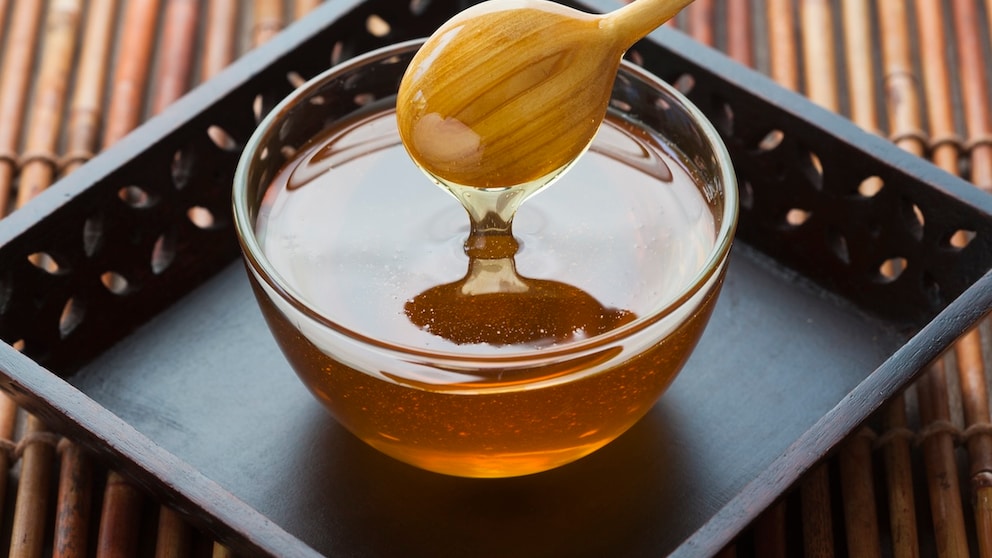February 6, 2025, 4:18 pm | Read time: 4 minutes
Honey is rich in amino acids, enzymes, and antioxidants. This makes it a common household remedy and a suitable sugar alternative, although it should be consumed in moderation due to its high calorie content. And you should also be careful when choosing a spoon to get the honey out of the jar – or should you? FITBOOK author Janine Riedle asked the experts.
Honey is the subject of much debate. This is because it is actually said to have many positive health properties. However, this is only the case if it is a good product and not one that has been diluted with sugar or syrup. In addition to choosing the right honey, there are also calls for it to be consumed in a very specific way – with a wooden spoon. FITBOOK explains the truth of this statement below.
Overview
Chemical Reaction with a Metal Spoon
Due to its ingredients, honey is said to have a wound-healing and antibacterial effect – and this knowledge goes back as far as ancient Egypt. The high sugar concentration, which is made up of around 85 percent fructose and glucose, ensures that fluid is osmotically drawn out of the surrounding tissue, and it can, therefore, support wound healing.1 In addition, the predominantly acidic environment of honey, which has a pH value of between three and four, prevents bacteria from multiplying.
If this acidic environment comes into contact with metal, this can cause a chemical reaction – or so it is assumed. This means that honey can react with a metal spoon. Possible consequences can be that the shelf life and quality are impaired, and the taste is adulterated.2 For this reason, wooden spoons specially developed for honey were used in the past.
“Wood Has Gone out of Fashion Among Beekeepers
There is hardly any information on whether honey should really only be eaten with a wooden spoon. There is a particular lack of scientific texts and studies. That’s why FITBOOK asked Dr. Melanie von Orlow, Chairwoman of the Berlin Beekeepers’ Association. She sees no reason why honey should not be consumed with other materials. “Honey is slightly acidic, but normal stainless steel tableware is, of course, perfectly suitable for transferring honey from the jar to the food,” she explains. According to the expert, glass and porcelain can also be used to consume honey.
And what about a wooden spoon? “Although wood is still often used for stirring and possibly portioning food, it is much more difficult to clean and keep clean due to gaps and cracks. There is also the risk of splintering,” says Dr. von Orlow. “With this in mind, stirring honey with a wooden triangular stick has rightly gone out of fashion among beekeepers.”
Different Spoon Materials
Dr. Marc-Wilhelm Kohfink from Imkerei am Pflanzengarten and a member of the Berlin Beekeepers’ Association, has a similar view to Dr. von Orlow. “I think that’s nonsense. Wooden spoons have an unpleasant mouthfeel,” says Dr. Kohfink. In his opinion, consuming honey works particularly well with a plastic spoon; he also has no reservations about metal spoons made of stainless steel and silver. “Honey is chemically an acidic food. I would therefore advise against using aluminum spoons because aluminum is known to react with acid.”

At the FITBOOK and STYLEBOOK event Charité doctor on honey: “Major areas of application are infection defense and wounds”

Nutrition myths fact-checked Better weight loss with lemon water before breakfast? Here’s what an expert says

Expert reveals Is honey healthier than sugar?
You Should Pay More Attention to This with Honey
When consuming honey, the focus should be less on the choice of spoon and more on the temperature. To take advantage of the health benefits of honey, for example, it is important not to heat the food above 38 degrees Celsius, as otherwise it loses its enzymatic properties, according to Dr. von Orlow. “It is, therefore, best to enjoy it from the jar at room temperature,” advises the chairwoman of the Berlin Beekeepers’ Association.
There is also something to bear in mind when it comes to storage. “It needs to be stored in a dark, cool place and in a tightly closed jar so that the honey doesn’t draw water and ferment,” explains Dr. von Orlow. However, it is not necessary to store the food in the refrigerator. “Such low temperatures can promote crystallization, i.e., clouding and solidification, but this does not mean a loss of quality.”

